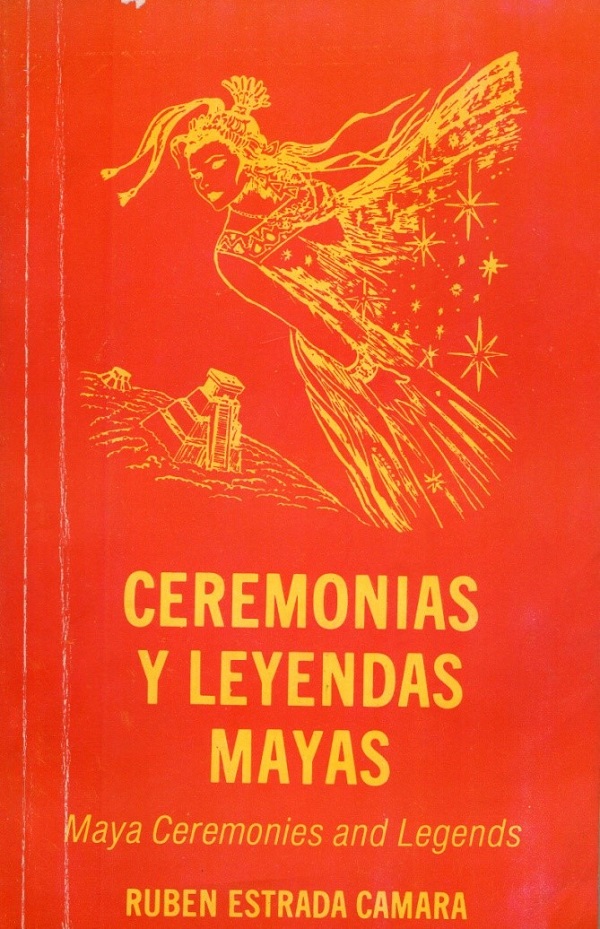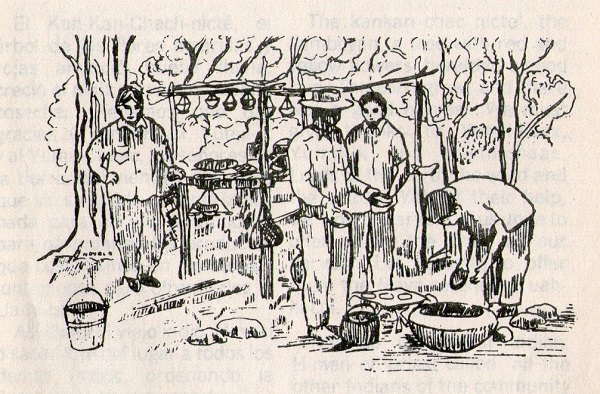Visitas: 0

Ceremonias y Leyendas Mayas
X
UAH-HI-COL
(Ceremonia Maya)
“El Kan-Kan-Chac-nicté, el árbol de las flores amarillas y rojas, anunció buena lluvia; creció el maíz y tuvimos buena cosecha. Tenemos que dar gracias al Yumil-Kaax, Yumil-Ik y al Yumil Chaac, los señores de la tierra, del viento y del agua, que sin su ayuda no tendríamos nada para comer. Juntémonos para ofrendarles el Uah-hi-col.”
Así llama el viejo indio, H-men o sacerdote del lugar, a todos los demás indios, ordenando la fiesta de la buena cosecha.
Son los meses del otoño, de las milpas cercanas al caserío. Hombres, mujeres y jóvenes traen sobre sus espaldas sacos llenos de mazorcas de maíz, frijoles, ibes, espelones, chiles, calabazas, tomates, cacahuates, olorosos melones, jugosas sandías. Se prepara la fiesta y la ceremonia de dar gracias al pan de la milpa.
El H-men señala la fecha y se escoge una casa cerca de un árbol llamado Ceiba, un árbol grande y frondoso.
En la mañana del día fijado, bajo sus ramas las mujeres muelen el maíz que les servirá para hacer los panes con la masa, cuecen los frijoles, las pepitas de las calabazas, y lo revuelven todo junto con la masa, formando unas bolas. Entonces lo cubren con hojas de plátano. Los hombres benefician a los pavos y los cuecen en grandes ollas de barro y hierbas aromáticas. Los muchachos cortan madera y forman un horno y, cuando está caliente, se hornean las bolas de masa junto con los pavos, calabazas y cacahuates.
Dos o tres horas durará el cocimiento. Durante este tiempo, las mujeres y hombres vuelven a sus hogares para regresar con sus trajes de fiesta; los muchachos traen sus flautas de barro y sus zacatanes que sonarán en el momento de la ofrenda de la comida de la milpa.
El tiempo ha transcurrido. Se destapa el horno y se separan los panes y los pavos. Con la carne y el pan las mujeres hacen una sopa que se llama Yaach y se ofrenda sobre una mesa que incluye el licor llamado Bal-ché y todos los demás productos que se cosechan en la milpa.
Al mediodía llega el H-men, se inclina sobre la mesa y musita unas palabras. Con una jícara esparce el licor Balché por los puntos cardinales. En ese momento los jóvenes comienzan a sonar sus flautas y zacatanes, el viento mueve las ramas de los árboles y algunos pajarillos se acercan al escuchar el sonido de los flautines.
El H-men se retira, la ceremonia ha terminado. Se sirve a todos los hombres en jicaritas el licor de Balché, las mujeres comen calabaza horneada con miel de colmena, y los muchachos cacahuate con sal.
Todos reciben su ración de comida que comen allí mismo, o la llevan a sus casas.
Al atardecer limpian el lugar y regresan a sus pequeñas chozas; el indio sonríe: su traje está lleno de maíz.
[Continuará la semana próxima…]
RUBÉN ESTRADA CÁMARA

UAH-HI-COL
(Mayan Ceremony)
“The Kankan chac nicte’, the flamboyan, a tree with red and yellow flowers, predicted a good rain. The corn grew, and there was a good harvest. We must thank Yumil-Kaax, Yumil-Ik and Yumil-Chaac, Lords of the earth, the wind and the water. Without their help, we would starve. Let us gather to offer them the fruit of our harvest. Let us gather to offer them the Mayan ceremony Uah-hi-col.”
So the oldest native H-men or priest summons all the other natives of the community to arrange for the celebration of the good harvest.
It is autumn, and from the fields come men, women and children, carrying on their shoulders sacks filled with corn, beans, chilies, squash, tomatoes, peanuts, pungent melons, and juicy watermelons. Preparations are begun for the ceremony to give thanks for the bountiful harvest.
The H-men announces the date and a house is chosen near a Ceiba, a large, leafy tree. On the chosen day, the women grind the corn which will be used for the bread, cook the beans, and squash seeds, to mix everything into a dough, which they cover with banana leaves. The men kill the turkeys and cook them in huge clay pots, and the young men cut wood and make an oven. When the oven is hot, they bake the dough, as well as the turkey, squash and peanuts.
Cooking takes two or three hours. During this time, the men and women go home to change and return in their party clothing. The boys bring their clay flutes and their drums that will be played during the offering.
Time passes. The oven is opened and the bread and the turkey are removed. The women then make yaach (a soup of the bread and meat), and place it on the table as an offering, along with the liquor balche’ and all the other products of the field.
The H-men arrives at noon. He leans over the table and mutters some words. He sprinkles balché in each of the cardinal directions. It is then that the young men begin to play the instruments; tree branches move in the wind, and small birds hover close by as they listen to the sound of the flutes.
The H-men leaves. The ceremony ends. Balche’ is served in small gourds to all the men, while the women eat squash baked with honey, and the youngsters nibble on salted peanuts.
Everyone is given a portion of food to eat there or carry home.
At dusk, they clean up and return to their huts. The natives smile: their storage bins are full of corn.
[To be continued next week…]
RUBÉN ESTRADA CÁMARA































